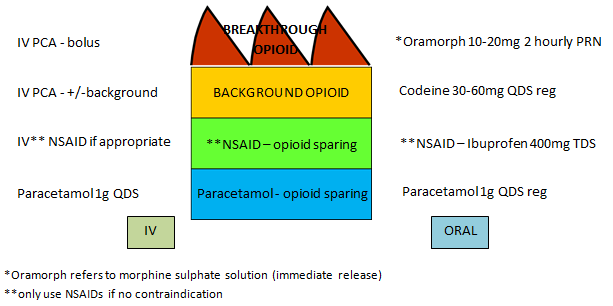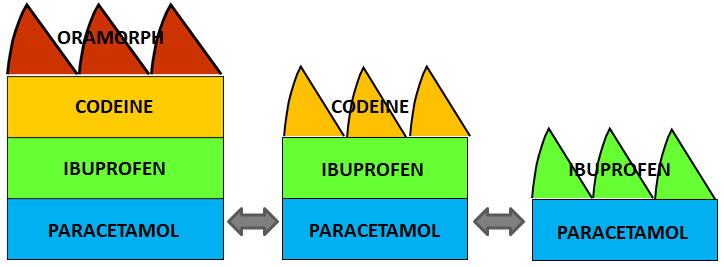How to prescribe analgesia
Basic management of pain
The principles of acute pain management are different than those for palliative pain management. The latter focus on comfort as a priority, with regular analgesia being paramount, and breakthrough analgesia being seen as a failure of the technique, requiring an increase in regular analgesia, often with modified-release opioids.
Acute pain management has its focus on function, with background analgesia (regular paracetamol, NSAIDs and weak opioids) being given for pain at rest, and prn short-acting strong opioids given for the peaks of pain precipitated by movement, dressing changes, physiotherapy etc. Modified-release strong opioids have no place in the management of intermittent peaks of acute pain.
The diagram below shows how basic analgesia should be built up to provide good pain control in most situations, with regular analgesia prescribed for background pain and prn analgesia prescribed for intermittent, breakthrough pain. The left side shows intravenous (IV) administration and the right side oral administration. IV should only be used if the patient is unable to absorb analgesia orally ( Starting a PCA).

If pain is not initially felt to be severe the analgesic plan can be started with PRN Codeine, and then increased if pain is not well controlled. Similarly, as tissue injury resolves and acute pain diminishes, the analgesic plan can be stepped down accordingly:

Conversely, if pain is severe despite regular opioid-sparing and weak opioid analgesia, and pro-active use of PRN strong opioids, then the weak opioid could be replaced by regular QDS strong opioids (eg Morphine immediate release), and the PRN Morphine continued.
Please note: modified release opioid preparations should not be initiated for patients with acute pain.
Drugs used for the management of acute pain:
Paracetamol Ibuprofen Naproxen Diclofenac Codeine Tramadol Dihydrocodeine Morphine Oxycodone
Remember that pain itself causes nausea and opioid analgesia will make this worse – always co-prescribe an antiemetic, and a laxative to prevent constipation.
